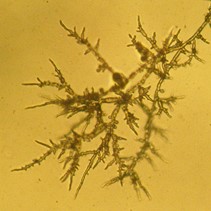
Version 10/23/2019
An inadequate sample can easily result in a false negative result. In container-grown plants, testing results are specific to the plant(s) and specific roots or other materials being tested. Even if tests were 100% efficient at detecting Phytophthora infections (they are not), the disease status of one plant does not directly indicate the disease status of other plants in the batch or nursery.
In a nursery with a high incidence of infected plants, it is often possible to detect Phytophthora with a fairly small number of samples using an efficient test. Consider a batch of plants in which 50% are infected. If you choose two plants at random from this batch, you have a good chance (3 out of 4 odds) that at least one will be infected. However, even at a 50% infection rate, you would still need to sample five plants at random to have more than a 95% chance of selecting an infected plant. If the test is less than 100% efficient at detecting Phytophthora, the number of samples would need to be further increased.
In a clean nursery following the Phytophthora BMPs, testing is conducted to detect accidental contamination events at an early stage, before they have a chance to spread widely though the nursery. The longer that infected plants remain undetected in the nursery, the greater chance there is for spread among adjacent plants. When monitoring plants produced under the Phytophthora BMPs, it is preferable to be able to detect contaminated plants at low infection rates, hopefully 1% or less. However, at an infection rate of 1%, individual plant tests would need to be conducted on about 300 plants to have a 95% chance of having at least one infected plant in the sample. Again, because no test will detect an infected plant 100% of the time, the number of plants tested would need to be even larger. If the infection rate is low (around 1%), it becomes impractical to do enough random testing of individual plants to detect Phytophthora with high reliability.
Hence, the first stage of successful sampling involves testing enough plants to ensure that at least one infected plant is included in the tested sample. The other major factor that affects whether Phytophthora can be detected in a batch of infected plants is the efficiency of the test method. In other words, if there is at least one infected plant in the sample, how frequently will the test yield a detection? Test efficiency is affected by two factors:
(1) Detection limit of the test (i.e., what is the smallest amount of pathogen in a sample that can be detected): Every method has a limit below which detection will not occur. DNA based methods such as PCR can detect very small amounts of DNA, potentially as little as a few molecules, although the process used to prepare the sample (e.g., extraction) can influence the minimum amount of DNA needed in the sample. For baiting, our own tests indicate that the absolute limit for pear baiting may be one to hundreds of zoospores, depending on the Phytophthora species.
(2) Sample potency (i.e., the amount of detectable pathogen material in the tested sample). To obtain a detection, the sample that is processed needs to have detectable pathogen material in an amount that is above the test detection limit. For instance, if a high percentage of the roots in a pot are infected, it will be relatively easy to sample enough roots to get some infected ones. This is most readily accomplished by removing the plant from the pot and examining the root system carefully for symptomatic roots. For methods such as direct isolation, immunoassay, and PCR, the amount of roots tested is miniscule, so careful selection of suitable roots is critical. Methods that rely on very small root samples may commonly generate false negatives if the percentage of infected roots is low or if root symptoms are ambiguous (e.g., if healthy roots do not differ markedly in appearance from infected roots). By comparison, whole-plant baiting techniques have the potential to be more efficient at detecting Phytophthora because they rely on inoculum present in the entire root. However, conditions for zoospore production, release, and infection of baits still need to be optimized to minimize false negatives.
Detection efficiency can also be affected by factors that interfere with the test. For instance, in direct isolation from roots, only small portions of the roots placed into selective media need to have viable Phytophthora infections or propagules. However, if the roots are also colonized by Pythium species, these faster-growing organisms can quickly overrun the isolation plate, masking any Phytophthora that might be present.
Recommendations: There is no single magic number of plants to test. Phytophthora detection is affected by the test method used, the infection rate in the tested batch, the amount of root infection within individual infected plants, and other factors discussed above. Because testing requires time and money, there are practical limits to how much testing can be done. In general, your ability to detect Phytophthora, if present, will be improved by using these practices:
For the bench leachate test method (section 3.4), we have used data from controlled tests and statistical models to determine how infection rate, test efficiency, and selective (not random) sampling interact to affect testing efficiency (see section 2.4).